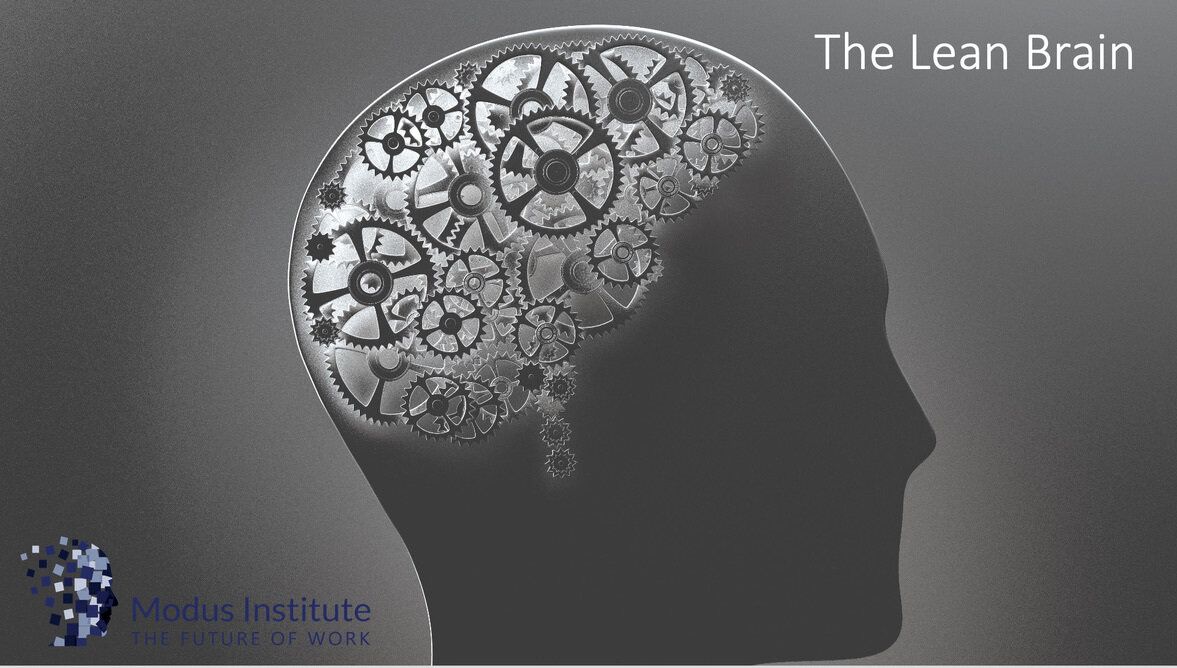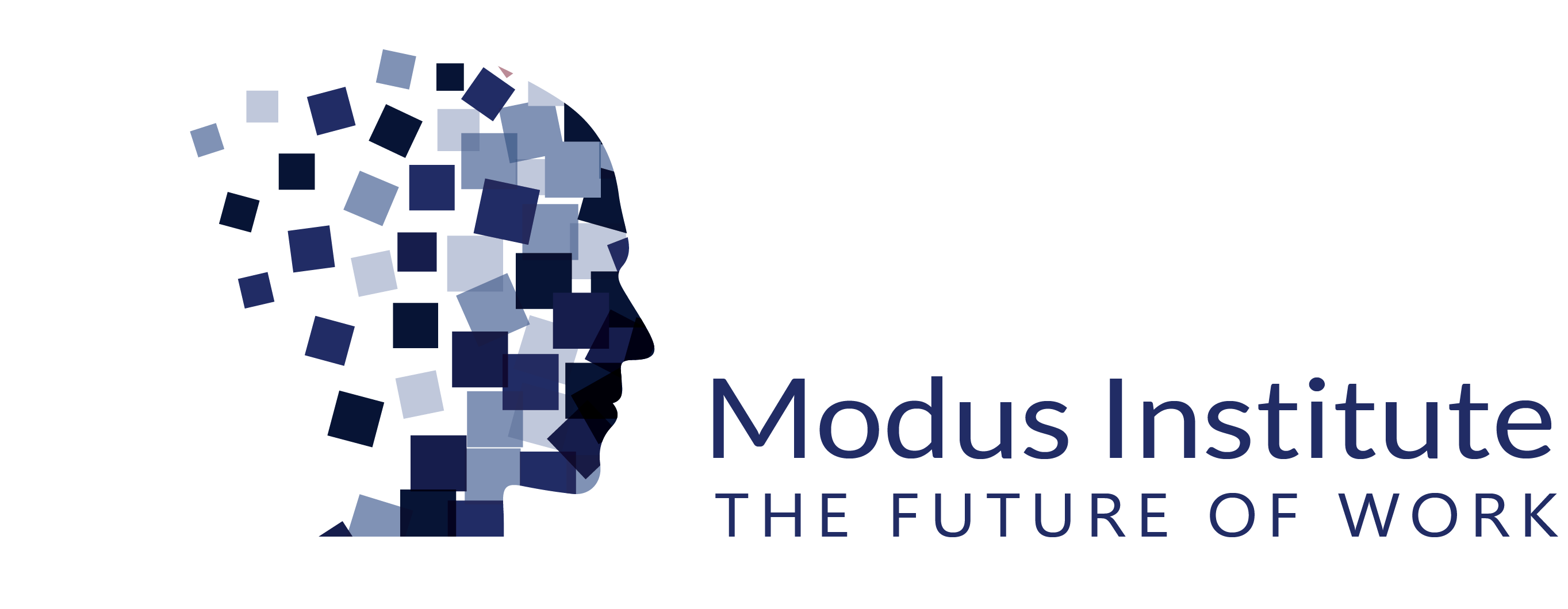Lean Principles Through the Lenses of Psychology
Tonianne DeMaria
While heading to a Lean event a while ago, I found myself confronted with a succession of thought-provoking signage. One in particular posed the following open-ended question:
All problem solvers must…
Given how the work we do at Modus Cooperandi and Modus Institute focuses largely on the nexus between Lean for knowledge work, behavioral economics, neuroscience, and the teachings of W. Edwards Deming, one follow-up sign’s response particularly resonated:
All problem solvers must…
Given how the work we do at Modus Cooperandi and Modus Institute focuses largely on the nexus between Lean for knowledge work, behavioral economics, neuroscience, and the teachings of W. Edwards Deming, one follow-up sign’s response particularly resonated:
Understand how their behaviors are contributing to the problem.
While Lean offers us a set of principles and practices to help us create value for our customers, for our organizations, and for ourselves, it’s our brains that seem to pose the greatest challenge to its successful implementation.
But it’s not our fault, you see. Our brains hate us.
Okay, so maybe that’s a bit harsh. They do nevertheless tend to act in their own self-interest to conserve cognitive energy - opting for rapidity over reason - often sabotaging our best intentions with their behavior-impacting shortcuts. Which is precisely what Jim Benson and I have encountered in the hundreds of workshops we’ve offered where we ask participants, What is your biggest impediment to implementing Lean principles?
While Lean offers us a set of principles and practices to help us create value for our customers, for our organizations, and for ourselves, it’s our brains that seem to pose the greatest challenge to its successful implementation.
But it’s not our fault, you see. Our brains hate us.
Okay, so maybe that’s a bit harsh. They do nevertheless tend to act in their own self-interest to conserve cognitive energy - opting for rapidity over reason - often sabotaging our best intentions with their behavior-impacting shortcuts. Which is precisely what Jim Benson and I have encountered in the hundreds of workshops we’ve offered where we ask participants, What is your biggest impediment to implementing Lean principles?

The universal response? Myself.
To understand why this is, we need to look no further than the System of Profound Knowledge (SoPK). With SoPK, Dr. Deming explains how people and processes are all part of a complex web of interrelated systems. Among those is our cognitive system.
In contrast to that which is found on the factory floor, knowledge worker’s “machinery” - their brains - can be capricious, rendering thought processes less than reliable and actions less than rational.
For Lean thinkers who engage in knowledge work, even a cursory understanding of how the brain can contribute to behaviors impeding Lean’s five key principles (as Dr. Deming instructs, having an understanding of psychology) is crucial to identifying where Lean efforts might become sabotaged.
To understand why this is, we need to look no further than the System of Profound Knowledge (SoPK). With SoPK, Dr. Deming explains how people and processes are all part of a complex web of interrelated systems. Among those is our cognitive system.
In contrast to that which is found on the factory floor, knowledge worker’s “machinery” - their brains - can be capricious, rendering thought processes less than reliable and actions less than rational.
For Lean thinkers who engage in knowledge work, even a cursory understanding of how the brain can contribute to behaviors impeding Lean’s five key principles (as Dr. Deming instructs, having an understanding of psychology) is crucial to identifying where Lean efforts might become sabotaged.
Lean Principle 1: Value is a Conversation

The first Lean principle states: Define Customer Value
Your brain says: I’ve seen this countless times before - I know what my customer needs better than they do.
What's at play here:
There’s an old story about a man standing along a riverbank. He doesn’t see a bridge, but he does see someone on the opposite bank fishing.
"Hey!" he shouts across the water. "How do I get to the other side of the river?"
The other man yells back, "You’re already on the other side of the river!"
Perspective. More than our own exists. Unfortunately we’re not wired to immediately see things beyond our own context and so from an anthropological standpoint, having a self-centered worldview makes perfect sense.
Man’s survival did not depend on knowing what his fellow hunter-gatherers thought, felt, or needed. Biologically speaking, seeing things from our own side of the proverbial river is cognitively expedient - it’s quick, convenient, and let’s face it practical.
Acknowledging there might be an alternative or even multiple perspectives, acknowledging “their there” might deviate from our own requires mental effort. When we fall into the trap of assuming only one truth, of applying a singular mental model, we miss inherent complexities and nuances obliterating not only the possibility of finding better alternatives, but we guarantee that we will deviate from the first Lean principle and at some point fall short of our customer’s expectations.
How to mitigate: Your gut instinct, your experience, your myriad belts and certifications and mastery aside, you do not know what your customer wants. And THEY are the arbiter of value, not you. Replace assumptions with humility and exploration. Ask open-ended questions. Endeavor to gain an unbiased understanding of - and deeper insight into - what your client explicitly wants and why.
Your brain says: I’ve seen this countless times before - I know what my customer needs better than they do.
What's at play here:
- Expertise bias
- Overconfidence effect
- Ivory tower syndrome
- Ego
There’s an old story about a man standing along a riverbank. He doesn’t see a bridge, but he does see someone on the opposite bank fishing.
"Hey!" he shouts across the water. "How do I get to the other side of the river?"
The other man yells back, "You’re already on the other side of the river!"
Perspective. More than our own exists. Unfortunately we’re not wired to immediately see things beyond our own context and so from an anthropological standpoint, having a self-centered worldview makes perfect sense.
Man’s survival did not depend on knowing what his fellow hunter-gatherers thought, felt, or needed. Biologically speaking, seeing things from our own side of the proverbial river is cognitively expedient - it’s quick, convenient, and let’s face it practical.
Acknowledging there might be an alternative or even multiple perspectives, acknowledging “their there” might deviate from our own requires mental effort. When we fall into the trap of assuming only one truth, of applying a singular mental model, we miss inherent complexities and nuances obliterating not only the possibility of finding better alternatives, but we guarantee that we will deviate from the first Lean principle and at some point fall short of our customer’s expectations.
How to mitigate: Your gut instinct, your experience, your myriad belts and certifications and mastery aside, you do not know what your customer wants. And THEY are the arbiter of value, not you. Replace assumptions with humility and exploration. Ask open-ended questions. Endeavor to gain an unbiased understanding of - and deeper insight into - what your client explicitly wants and why.
Lean Principle 2: Visualization Begets Alignment

The second Lean principle states: Map the Value Stream.
Your brain says: I’ve been doing this so long, it’s become second nature to me. The steps are right here - in my head.
What’s at play here:
It was day four of their value stream mapping exercise and tempers were beginning to fray. Despite having worked together for years, the members of this outwardly cohesive development team struggled to identify the basic activities needed to create value for their customer.
While at 17 process “steps” they agreed they were close to completing a first pass of their map, they couldn’t seem to reach alignment when it came to certain conditions and boundaries and for some, even the target remained nebulous.
If they couldn’t agree on how they currently operate - without that clear baseline - how could they improve their future state?
Oftentimes the curse of expertise is the assumption that other people’s interpretation of events matches our own. So long as the value stream is left implicit, the steps - the order, the handoffs, the standards - are highly subjective. As a result, effort is duplicated. Unnecessary churn occurs. Bottlenecks and work starvation become business as usual. And no one seems to notice.
How to mitigate: Especially when it comes to non-routine creative work, eliminate assumptions and normalize expectations by making the current state explicit. Visualizing steps essential to the process exposes mismatches, surfaces non-value-added steps (waste), and promotes constancy of purpose.
Your brain says: I’ve been doing this so long, it’s become second nature to me. The steps are right here - in my head.
What’s at play here:
- Illusion of transparency
- Curse of knowledge/information imbalance
- Status quo thinking
- Groupthink/false consensus effect
- Availability bias
It was day four of their value stream mapping exercise and tempers were beginning to fray. Despite having worked together for years, the members of this outwardly cohesive development team struggled to identify the basic activities needed to create value for their customer.
While at 17 process “steps” they agreed they were close to completing a first pass of their map, they couldn’t seem to reach alignment when it came to certain conditions and boundaries and for some, even the target remained nebulous.
If they couldn’t agree on how they currently operate - without that clear baseline - how could they improve their future state?
Oftentimes the curse of expertise is the assumption that other people’s interpretation of events matches our own. So long as the value stream is left implicit, the steps - the order, the handoffs, the standards - are highly subjective. As a result, effort is duplicated. Unnecessary churn occurs. Bottlenecks and work starvation become business as usual. And no one seems to notice.
How to mitigate: Especially when it comes to non-routine creative work, eliminate assumptions and normalize expectations by making the current state explicit. Visualizing steps essential to the process exposes mismatches, surfaces non-value-added steps (waste), and promotes constancy of purpose.
Lean Principle 3: Flow - You Can't Step in the Same River Twice

The third Lean principle states: Manage Flow
Your brain says: My work isn’t linear. My day is filled with interruptions and so I don’t have the “luxury” of flow.
What’s at play here: Functional fixedness.
If there is one area where there’s not an obvious transfer of Lean principles from manufacturing to knowledge work, it’s understanding how flow can in fact be achieved when work is creative and contextual rather than isolated and prefigured.
On the factory floor, workers create a fairly static set of tangible products in a predictable way, while constantly aiming to reduce variation to produce uniform output.
In the office, whether their work products are largely inventive (e.g. software development) or relatively standardized (responding to a customer service call, for instance), knowledge work is fraught with variation.
Myriad people, products, projects, processes, experience levels, and information sources (both tacit and explicit), coupled with the requests for clarity and/or adjustment these constituencies make can combine and compete to create a sometimes bewildering if not cacophonous work environment.
Confusing and noisy - yes. Wasteful? Probably not. Quite the contrary, in fact.
In knowledge work, value is created through often unplanned human interaction. Water cooler conversations, instant message exchanges, seemingly interminable and ostensibly “useless” meetings, and serendipity combine to create customer value. Indeed, oftentimes customers themselves end up contributing to this continuous conversation.
Office workers usually have multiple projects with their own constituencies, deliverables, and anomalies. This creates a “noisy” interdependent environment with a very different relationship to variation than the one that exists on the shop floor. When it comes to knowledge work, variation - change - is a constant. No two financial audits will occur the same way. No two court cases will require the same strategy. No two treatment plans will offer the same course of action.
Oftentimes this change is how an organization learns. In the office, learning is the driver of successful projects, myriad improvements, and satisfied stakeholders.
Because of this, knowledge workers’ value streams have a short shelf life. This does not mean they have no value stream, nor does it mean that their value streams are an effort in futility. Rather, their value streams ebb and flow with the work itself. They will stabilize and allow for the creation of a project-specific value-stream, but one which will always require continuous adjustment and improvement.
Therefore in knowledge work, flow comes not through relentless standardization and waste reduction, but through the continuous optimization of processes with a very short shelf-life. When it comes to optimizing flow in the office, the value stream is in a perpetual state of kaizen (which will be discussed in the next section).
How to mitigate: In the office, flow is interrupted not by communication per se, but by unnecessary communication or the interruption of focus. For an individual or a team, focus is maintained when they have a single task that they are allowed to complete unimpeded.
The issue in the office is that countless tasks are being processed simultaneously and whether they are self-imposed or external, interruptions are both frequent and inevitable. This is necessary for the organization’s learning, but it does not have to happen chaotically. They can be batched to process similar tasks together. They can be analyzed to see where they emanate from and why. They can be scheduled. They can be processed more thoughtfully.
Visualizing work as a team, along with interruptions, allows team members to see when an interruption is least disruptive. Limiting WIP lowers the amount of potential interruptions (less people asking for status or seeking additional information). And approaches like working meetings and the Pomodoro Technique allow staff to sequester themselves for short periods of dedicated focus.
The overall goal to achieve flow in the office rests on creating pockets of focus to allow work to achieve completion. We do not however, want to over-regulate work or stifle conversation because while it is often unplanned, this type of variation is where true learning occurs.
Your brain says: My work isn’t linear. My day is filled with interruptions and so I don’t have the “luxury” of flow.
What’s at play here: Functional fixedness.
If there is one area where there’s not an obvious transfer of Lean principles from manufacturing to knowledge work, it’s understanding how flow can in fact be achieved when work is creative and contextual rather than isolated and prefigured.
On the factory floor, workers create a fairly static set of tangible products in a predictable way, while constantly aiming to reduce variation to produce uniform output.
In the office, whether their work products are largely inventive (e.g. software development) or relatively standardized (responding to a customer service call, for instance), knowledge work is fraught with variation.
Myriad people, products, projects, processes, experience levels, and information sources (both tacit and explicit), coupled with the requests for clarity and/or adjustment these constituencies make can combine and compete to create a sometimes bewildering if not cacophonous work environment.
Confusing and noisy - yes. Wasteful? Probably not. Quite the contrary, in fact.
In knowledge work, value is created through often unplanned human interaction. Water cooler conversations, instant message exchanges, seemingly interminable and ostensibly “useless” meetings, and serendipity combine to create customer value. Indeed, oftentimes customers themselves end up contributing to this continuous conversation.
Office workers usually have multiple projects with their own constituencies, deliverables, and anomalies. This creates a “noisy” interdependent environment with a very different relationship to variation than the one that exists on the shop floor. When it comes to knowledge work, variation - change - is a constant. No two financial audits will occur the same way. No two court cases will require the same strategy. No two treatment plans will offer the same course of action.
Oftentimes this change is how an organization learns. In the office, learning is the driver of successful projects, myriad improvements, and satisfied stakeholders.
Because of this, knowledge workers’ value streams have a short shelf life. This does not mean they have no value stream, nor does it mean that their value streams are an effort in futility. Rather, their value streams ebb and flow with the work itself. They will stabilize and allow for the creation of a project-specific value-stream, but one which will always require continuous adjustment and improvement.
Therefore in knowledge work, flow comes not through relentless standardization and waste reduction, but through the continuous optimization of processes with a very short shelf-life. When it comes to optimizing flow in the office, the value stream is in a perpetual state of kaizen (which will be discussed in the next section).
How to mitigate: In the office, flow is interrupted not by communication per se, but by unnecessary communication or the interruption of focus. For an individual or a team, focus is maintained when they have a single task that they are allowed to complete unimpeded.
The issue in the office is that countless tasks are being processed simultaneously and whether they are self-imposed or external, interruptions are both frequent and inevitable. This is necessary for the organization’s learning, but it does not have to happen chaotically. They can be batched to process similar tasks together. They can be analyzed to see where they emanate from and why. They can be scheduled. They can be processed more thoughtfully.
Visualizing work as a team, along with interruptions, allows team members to see when an interruption is least disruptive. Limiting WIP lowers the amount of potential interruptions (less people asking for status or seeking additional information). And approaches like working meetings and the Pomodoro Technique allow staff to sequester themselves for short periods of dedicated focus.
The overall goal to achieve flow in the office rests on creating pockets of focus to allow work to achieve completion. We do not however, want to over-regulate work or stifle conversation because while it is often unplanned, this type of variation is where true learning occurs.
Lean Principle 4: Push is Blind. Pull is Informed. See Beyond the Silo

The fourth Lean principle states: Establish Pull
Your brain says: I work best under stress! Chaos motivates me!
What’s at play here:
- Brain on stress
- Learned helplessness
Most of us have seen the iconic “Job Switching” episode of I Love Lucy, where the titular character and her BFF Ethel find themselves doing a stint as line workers at Kramer’s Candy Kitchen. Subjected to organizational silos and a despotic supervisor who rules with a capricious conveyor belt and leads with the threat of expulsion, the women’s only KPI is to ensure not a single piece of candy makes it into the packing room unwrapped. Aligning their performance to this solitary target, they resort to hiding unwrapped chocolates in their mouths, their blouses and most memorably, in Lucy’s oversized chef’s hat.
Their excessive WIP and struggle to keep apace at 100% utilization, coupled with a toxic KPI which makes zero mention of producing a quality product, creates a system that forces an overwhelmed Lucy and Ethel to produce defects and hide wasted inventory necessitating rework, causing stress and chaos, and ultimately resulting in burnout (not to mention their respective stomach aches and ultimate dismissals from the company).
At this candy factory, supply rather than demand drives the process. Work is being pushed onto Lucy and Ethel when they have neither the capacity to process it nor a signaling mechanism to slow it down or make it stop when a moment to breathe is needed.
Upstream workers in the kitchen have no insight into the capacity of downstream workers in the wrapping room and in turn, workers downstream in the packing room are no doubt starved for work as they are left waiting for product.
Devoid of any context beyond their own work station, the hapless line workers - through no fault of their own - are oblivious to the fact that the wrapping room is part of a larger system. As a result, they are incapable of seeing the impact of their work-as-a-bottleneck on other parts of the value stream.
When we become overloaded, we focus myopically on our tasks rather than on their flow. Constantly forced to react we fail to be thoughtful about what it is we are doing, conceding control over our situation. Confronted with our own lack of agency we default to relying on others to push work on us, rather than pull it ourselves. Once this learned helplessness takes over, flow breaks down, and any hope for kaizen becomes futile.
How to mitigate:
This classic TV clip masterfully breaks almost every tenet of Lean thinking. Lucy and Ethel lack clarity over their roles, their goals, and their value stream. Тhey have no visualization mechanism to understand their own capacity or a communication mechanism to convey that capacity (or lack thereof) to others. They are assigned to a supervisor who rates rather than develops their performance.
Nonetheless, they’re driven by fear in the form of a useless KPI. Last but not least, they are afforded zero respect (agency) to stop the process when problems arise nor do they have the slack or support to so much as suggest improving their process.
Pull requires us to build thoughtful systems that allow for upstream and downstream transparency, continuous feedback, respect-as-agency, and easy adjustment to ensure changes and improvements are made in context.
Pull provides pockets of predictability and pause, allowing downstream workers to plan for, focus on, and complete work with quality while having enough slack to pursue kaizen opportunities.
Whereas pull in manufacturing seeks to prevent overproduction, so too does pull in a knowledge work setting.
What is overproduction in knowledge work? Burnout.
While extreme stress might serve as a positive motivator for physical performance and as such, prove beneficial to athletes, studies show it has the opposite effect on knowledge workers, impacting cognitive capacity - actually contributing to WIP - compromising overall performance and quality.
Whether actual or perceived, physical or cognitive, extreme stress activates the brain’s threat circuitry, shutting down all non-essential functions so as to direct the body’s attention towards eradicating the potential danger. Among those functions considered “non-essential” are digestion, the immune system, and most important to knowledge workers, higher level thinking.
When we are stressed, the neurotransmitter dopamine floods the prefrontal cortex - the part of the brain responsible for executive functions - which includes our ability to concentrate, plan, organize, memorize, learn, problem-solve - the very skills essential to knowledge workers.
Utilizing a light-weight, flexible visual control like a Personal Kanban provides knowledge workers with a framework for understanding personal and team workloads and workflow. It gives them transparency into both the upstream supplier and the downstream customer’s context, as well as the opportunity to recognize and communicate to others their capacity to take on or defer more work.
The associated WIP limit prevents them from taking on more work than they can handle, limiting cognitive stress thus allowing them to focus on and finish with quality only those tasks they have the mental capacity to process.

Lean Principle 5: Improvement is Not an Option

The fifth Lean principle states: Seek Perfection
What your brain says: This is the way we’ve always done things around here. If it ain’t broke, don’t fix it. It’s not “my job” to improve.
What’s at play here:
- Status quo bias
- Zero-risk bias
- Resistance to change
- Learned helplessness
While Lean’s focus on respect for people endows the worker with the ability to implement change for improvement’s sake as they see fit, that sense of agency must be coupled with the psychological safety that allows them the freedom to fail.
Only in a safe-to-fail environment - one where employees are comfortable being vulnerable seeking out problems, challenging the status quo, and attempting to solve sticky problems - can we tap into workers’ deepest potential and produce a culture of learners, experimenters, and creative problem-solvers, hallmarks of a successful Lean culture, one that recognizes overlooking human potential is among the greatest organizational wastes.
One way to accomplish this is to ensure that the risk of failure is kept to a minimum.
Why?
Our brains are wired to do two things exceptionally well: to minimize risk, and maximize reward. Motivated to affect these ends in the service of our survival, our brains place a premium on certainty. Not only is exploring something novel energy intensive (creating new neural pathways requires work), any deviation from the status quo - even if it is in own own best interest - is perceived as a risk to be avoided. Cutting edge approaches, untested actions that run counter to the familiar present themselves as a threat to our brains much in the way the rustle of a potential predator lurking in the tall grass did for prehistoric man.
Despite its neuroplasticity, our brains are predisposed to resist the ambiguity inherent to change and the resultant stress science shows, triggers actual physiological discomfort.
So despite recognition that current conditions could benefit from improvement, it is understandable that we instinctively frame conversations about change in terms of its (perceived) risk rather than its potential (perceived) reward.
To be sure, there’s an obvious irony at play here: man’s survival as a species was and remains indebted to its ability to adapt to its ever-changing environment. While our brains might intensely dislike and do everything it can to resist change, neuroplasticity nevertheless allows it to create new neural pathways and by extension, new habits.
Which is fortunate. Because for both the individual and the organization in which s/he works, maintaining the status quo is a risk.
How to mitigate:
Evolutionary trumps revolutionary. Research reveals that large changes engage the amygdala - the part of our limbic system that processes emotions and responds to threats.
When it comes to taking steps towards improvement, the brain likes its change in comfortable doses.
Small scale, incremental improvements are powerful because the proposed change bypasses the amygdala – the brain’s fight or flight mechanism – so there is less resistance, less fear of the unknown and by extension, less fear of failure.
Not only are gradual changes physiologically more comfortable to engage in, they likewise have a lower cost of failure, and are easier to sustain and build upon.

We are an online educational platform that helps professionals and aspiring individuals to succeed in their goals.
Copyright © 2025